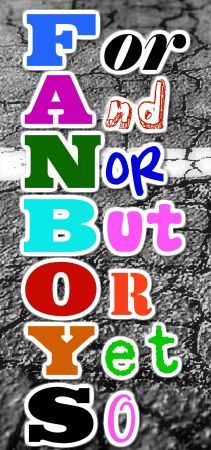Commas Part 3: Compound Sentences
Parts 1 and 2 of the comma posts talked about the series, or Oxford, comma. A series is a listing of three or more words, phrases, clauses, or sentences. This post talks about using commas with compound sentences.
A compound sentence consists of two sentences joined together with either a semicolon or with a comma and a conjunction.
You can join two sentences together with a semicolon if the two sentences are closely related to each other. That is a decision for you to make. (You never have to use the semicolon to join sentences, though.) For example
I am moving to Southern California; my sister lives in Northern California.
If you have been listening to me or reading my books , you probably know that you cannot join two sentences with a comma unless you also use a coordinating conjunction. The most common of these is and. However, there are six more of these conjunctions, and together they spell FANBOYS: for, and, nor, but, or, yet, so. Here are examples of compound sentences using each of the FANBOYS. They are not interchangeable, and which one you use depends on the sentence.
I am moving to Southern California, and I am taking my three dogs with me.
I am moving to Southern California, for I don’t like the cold weather of Chicago.
I do not like the snow, nor do I like the cold weather.
I am moving to Southern California, but the rest of my family is staying in Chicago.
I am moving to Southern California, or I am going to freeze to death!
I don’t like the cold weather, yet I love the culture of Chicago.
I don’t want to shovel any more snow, so I am moving to Southern California.
Notice that there is no T in the word FANBOYS; therefore the word then is NOT a conjunction:
I am moving to Southern California, then I am throwing my snow shovel away! WRONG
I am moving to Southern California, and then I am throwing my snow shovel away! RIGHT
Of course these coordinating conjunctions are used to connect words, phrases, and clauses too; they are not just used in compound sentences. For example
Jack and Jill went up the hill. (connecting two words – no comma with two words)
Do you want fish or chicken? (connecting two words)
Did he go into the garage or across the street? (connecting two phrases – no comma with two phrases)
She didn’t talk to me either before the movie started or after our friends left. (connecting two clauses – no comma)
So generally you do not use a comma when there are just two words, phrases, or clauses. However, sometimes with but or yet you can, because the two things are opposites. But that is another blog post!
She was tiny, yet fierce.
The movie was good, but violent.
Let’s get back to the comma in compound sentences . . . here are two things to remember:
If the compound sentence is really short, you do not need a comma. The comma is mainly for ease of reading.
I came home and I went to bed.
She sang and she danced.
Make sure your sentence is really compound before you use the comma. That is, the text before the conjunction and the text after the conjunction are both complete sentences with subjects and verbs. If the text after the conjunction is not a complete sentence, there is no comma.
I went to college in Florida, and I attended graduate school in California. (compound)
I went to college in Florida and attended graduate school in California. (not compound – no subject after the and)
Are you going to vacation in Europe this year, or are you going to stay home?
Are you going to vacation in Europe this year or just stay home?
NEWS:
You might be interested in the news release The Grammar Diva put out this week.
NEXT WEEK:
Why, a Halloween post, of course!




